Epidemiology and Public Health Report: Salmonella Infection
VerifiedAdded on 2022/09/14
|8
|1657
|49
Report
AI Summary
This report provides a comprehensive analysis of Salmonella infection, a common bacterial disease affecting the digestive tracts of humans and animals. It begins with an overview of the disease, including its causes, symptoms (such as abdominal cramps, diarrhea, and fever), mode of transmission through contaminated food and water, and potential complications like dehydration and bacteremia. The report then delves into the determinants of health, encompassing lifestyle, environment, nutrition, and genetics, and how these factors contribute to the development of Salmonella infection. The epidemiological triad—host, agent, and environmental factors—is examined in detail, highlighting the interplay of these elements in the spread and impact of the disease. Finally, the report defines the crucial role of Nurse Practitioners (NPs) in managing Salmonella infections, including education, screening, active management, and participation in research, integrating evidence-based practices and models of care to improve patient outcomes and public health. The report references various studies to support its findings.

Salmonella
Student name
University Name
Student name
University Name
Paraphrase This Document
Need a fresh take? Get an instant paraphrase of this document with our AI Paraphraser
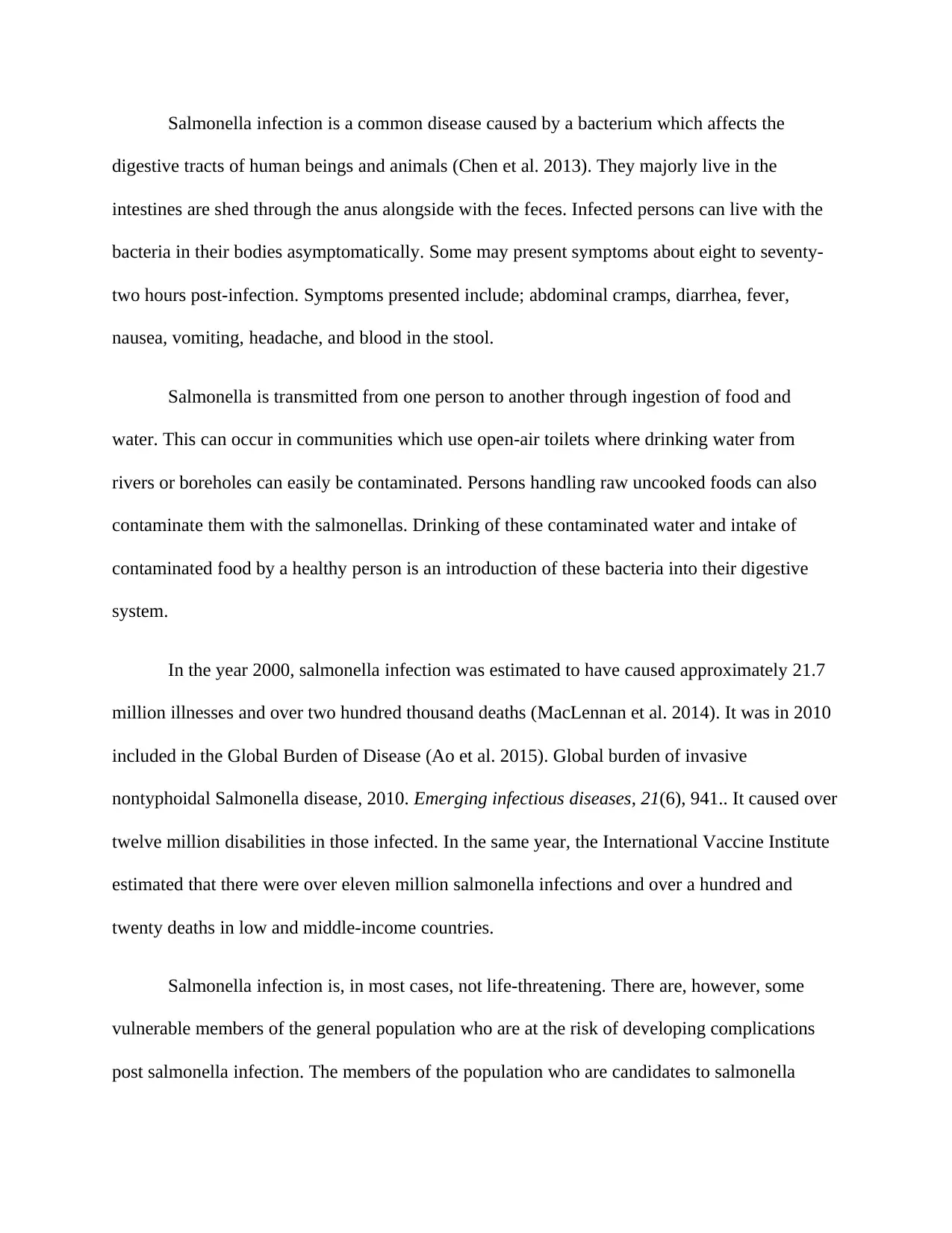
Salmonella infection is a common disease caused by a bacterium which affects the
digestive tracts of human beings and animals (Chen et al. 2013). They majorly live in the
intestines are shed through the anus alongside with the feces. Infected persons can live with the
bacteria in their bodies asymptomatically. Some may present symptoms about eight to seventy-
two hours post-infection. Symptoms presented include; abdominal cramps, diarrhea, fever,
nausea, vomiting, headache, and blood in the stool.
Salmonella is transmitted from one person to another through ingestion of food and
water. This can occur in communities which use open-air toilets where drinking water from
rivers or boreholes can easily be contaminated. Persons handling raw uncooked foods can also
contaminate them with the salmonellas. Drinking of these contaminated water and intake of
contaminated food by a healthy person is an introduction of these bacteria into their digestive
system.
In the year 2000, salmonella infection was estimated to have caused approximately 21.7
million illnesses and over two hundred thousand deaths (MacLennan et al. 2014). It was in 2010
included in the Global Burden of Disease (Ao et al. 2015). Global burden of invasive
nontyphoidal Salmonella disease, 2010. Emerging infectious diseases, 21(6), 941.. It caused over
twelve million disabilities in those infected. In the same year, the International Vaccine Institute
estimated that there were over eleven million salmonella infections and over a hundred and
twenty deaths in low and middle-income countries.
Salmonella infection is, in most cases, not life-threatening. There are, however, some
vulnerable members of the general population who are at the risk of developing complications
post salmonella infection. The members of the population who are candidates to salmonella
digestive tracts of human beings and animals (Chen et al. 2013). They majorly live in the
intestines are shed through the anus alongside with the feces. Infected persons can live with the
bacteria in their bodies asymptomatically. Some may present symptoms about eight to seventy-
two hours post-infection. Symptoms presented include; abdominal cramps, diarrhea, fever,
nausea, vomiting, headache, and blood in the stool.
Salmonella is transmitted from one person to another through ingestion of food and
water. This can occur in communities which use open-air toilets where drinking water from
rivers or boreholes can easily be contaminated. Persons handling raw uncooked foods can also
contaminate them with the salmonellas. Drinking of these contaminated water and intake of
contaminated food by a healthy person is an introduction of these bacteria into their digestive
system.
In the year 2000, salmonella infection was estimated to have caused approximately 21.7
million illnesses and over two hundred thousand deaths (MacLennan et al. 2014). It was in 2010
included in the Global Burden of Disease (Ao et al. 2015). Global burden of invasive
nontyphoidal Salmonella disease, 2010. Emerging infectious diseases, 21(6), 941.. It caused over
twelve million disabilities in those infected. In the same year, the International Vaccine Institute
estimated that there were over eleven million salmonella infections and over a hundred and
twenty deaths in low and middle-income countries.
Salmonella infection is, in most cases, not life-threatening. There are, however, some
vulnerable members of the general population who are at the risk of developing complications
post salmonella infection. The members of the population who are candidates to salmonella
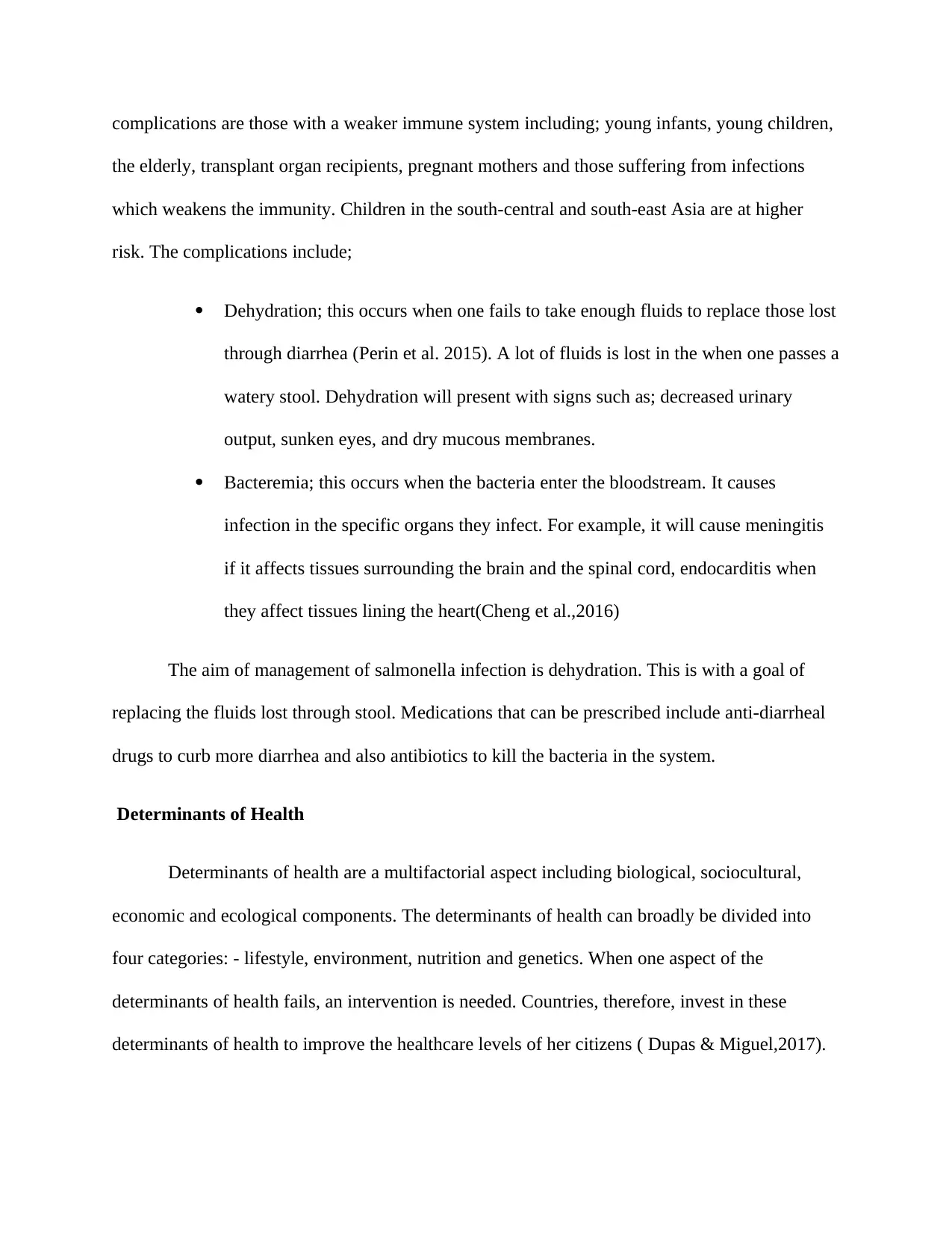
complications are those with a weaker immune system including; young infants, young children,
the elderly, transplant organ recipients, pregnant mothers and those suffering from infections
which weakens the immunity. Children in the south-central and south-east Asia are at higher
risk. The complications include;
Dehydration; this occurs when one fails to take enough fluids to replace those lost
through diarrhea (Perin et al. 2015). A lot of fluids is lost in the when one passes a
watery stool. Dehydration will present with signs such as; decreased urinary
output, sunken eyes, and dry mucous membranes.
Bacteremia; this occurs when the bacteria enter the bloodstream. It causes
infection in the specific organs they infect. For example, it will cause meningitis
if it affects tissues surrounding the brain and the spinal cord, endocarditis when
they affect tissues lining the heart(Cheng et al.,2016)
The aim of management of salmonella infection is dehydration. This is with a goal of
replacing the fluids lost through stool. Medications that can be prescribed include anti-diarrheal
drugs to curb more diarrhea and also antibiotics to kill the bacteria in the system.
Determinants of Health
Determinants of health are a multifactorial aspect including biological, sociocultural,
economic and ecological components. The determinants of health can broadly be divided into
four categories: - lifestyle, environment, nutrition and genetics. When one aspect of the
determinants of health fails, an intervention is needed. Countries, therefore, invest in these
determinants of health to improve the healthcare levels of her citizens ( Dupas & Miguel,2017).
the elderly, transplant organ recipients, pregnant mothers and those suffering from infections
which weakens the immunity. Children in the south-central and south-east Asia are at higher
risk. The complications include;
Dehydration; this occurs when one fails to take enough fluids to replace those lost
through diarrhea (Perin et al. 2015). A lot of fluids is lost in the when one passes a
watery stool. Dehydration will present with signs such as; decreased urinary
output, sunken eyes, and dry mucous membranes.
Bacteremia; this occurs when the bacteria enter the bloodstream. It causes
infection in the specific organs they infect. For example, it will cause meningitis
if it affects tissues surrounding the brain and the spinal cord, endocarditis when
they affect tissues lining the heart(Cheng et al.,2016)
The aim of management of salmonella infection is dehydration. This is with a goal of
replacing the fluids lost through stool. Medications that can be prescribed include anti-diarrheal
drugs to curb more diarrhea and also antibiotics to kill the bacteria in the system.
Determinants of Health
Determinants of health are a multifactorial aspect including biological, sociocultural,
economic and ecological components. The determinants of health can broadly be divided into
four categories: - lifestyle, environment, nutrition and genetics. When one aspect of the
determinants of health fails, an intervention is needed. Countries, therefore, invest in these
determinants of health to improve the healthcare levels of her citizens ( Dupas & Miguel,2017).
⊘ This is a preview!⊘
Do you want full access?
Subscribe today to unlock all pages.

Trusted by 1+ million students worldwide
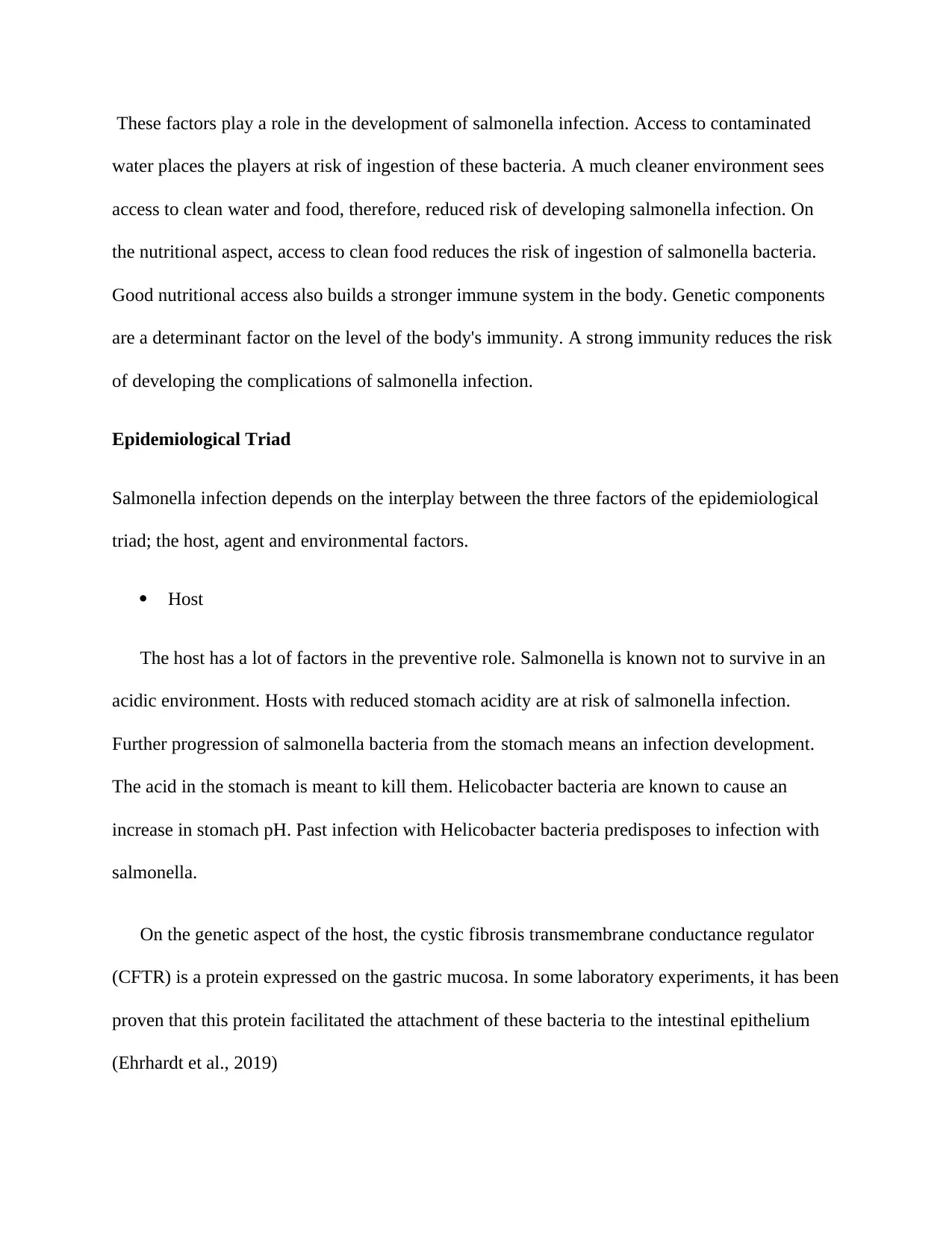
These factors play a role in the development of salmonella infection. Access to contaminated
water places the players at risk of ingestion of these bacteria. A much cleaner environment sees
access to clean water and food, therefore, reduced risk of developing salmonella infection. On
the nutritional aspect, access to clean food reduces the risk of ingestion of salmonella bacteria.
Good nutritional access also builds a stronger immune system in the body. Genetic components
are a determinant factor on the level of the body's immunity. A strong immunity reduces the risk
of developing the complications of salmonella infection.
Epidemiological Triad
Salmonella infection depends on the interplay between the three factors of the epidemiological
triad; the host, agent and environmental factors.
Host
The host has a lot of factors in the preventive role. Salmonella is known not to survive in an
acidic environment. Hosts with reduced stomach acidity are at risk of salmonella infection.
Further progression of salmonella bacteria from the stomach means an infection development.
The acid in the stomach is meant to kill them. Helicobacter bacteria are known to cause an
increase in stomach pH. Past infection with Helicobacter bacteria predisposes to infection with
salmonella.
On the genetic aspect of the host, the cystic fibrosis transmembrane conductance regulator
(CFTR) is a protein expressed on the gastric mucosa. In some laboratory experiments, it has been
proven that this protein facilitated the attachment of these bacteria to the intestinal epithelium
(Ehrhardt et al., 2019)
water places the players at risk of ingestion of these bacteria. A much cleaner environment sees
access to clean water and food, therefore, reduced risk of developing salmonella infection. On
the nutritional aspect, access to clean food reduces the risk of ingestion of salmonella bacteria.
Good nutritional access also builds a stronger immune system in the body. Genetic components
are a determinant factor on the level of the body's immunity. A strong immunity reduces the risk
of developing the complications of salmonella infection.
Epidemiological Triad
Salmonella infection depends on the interplay between the three factors of the epidemiological
triad; the host, agent and environmental factors.
Host
The host has a lot of factors in the preventive role. Salmonella is known not to survive in an
acidic environment. Hosts with reduced stomach acidity are at risk of salmonella infection.
Further progression of salmonella bacteria from the stomach means an infection development.
The acid in the stomach is meant to kill them. Helicobacter bacteria are known to cause an
increase in stomach pH. Past infection with Helicobacter bacteria predisposes to infection with
salmonella.
On the genetic aspect of the host, the cystic fibrosis transmembrane conductance regulator
(CFTR) is a protein expressed on the gastric mucosa. In some laboratory experiments, it has been
proven that this protein facilitated the attachment of these bacteria to the intestinal epithelium
(Ehrhardt et al., 2019)
Paraphrase This Document
Need a fresh take? Get an instant paraphrase of this document with our AI Paraphraser
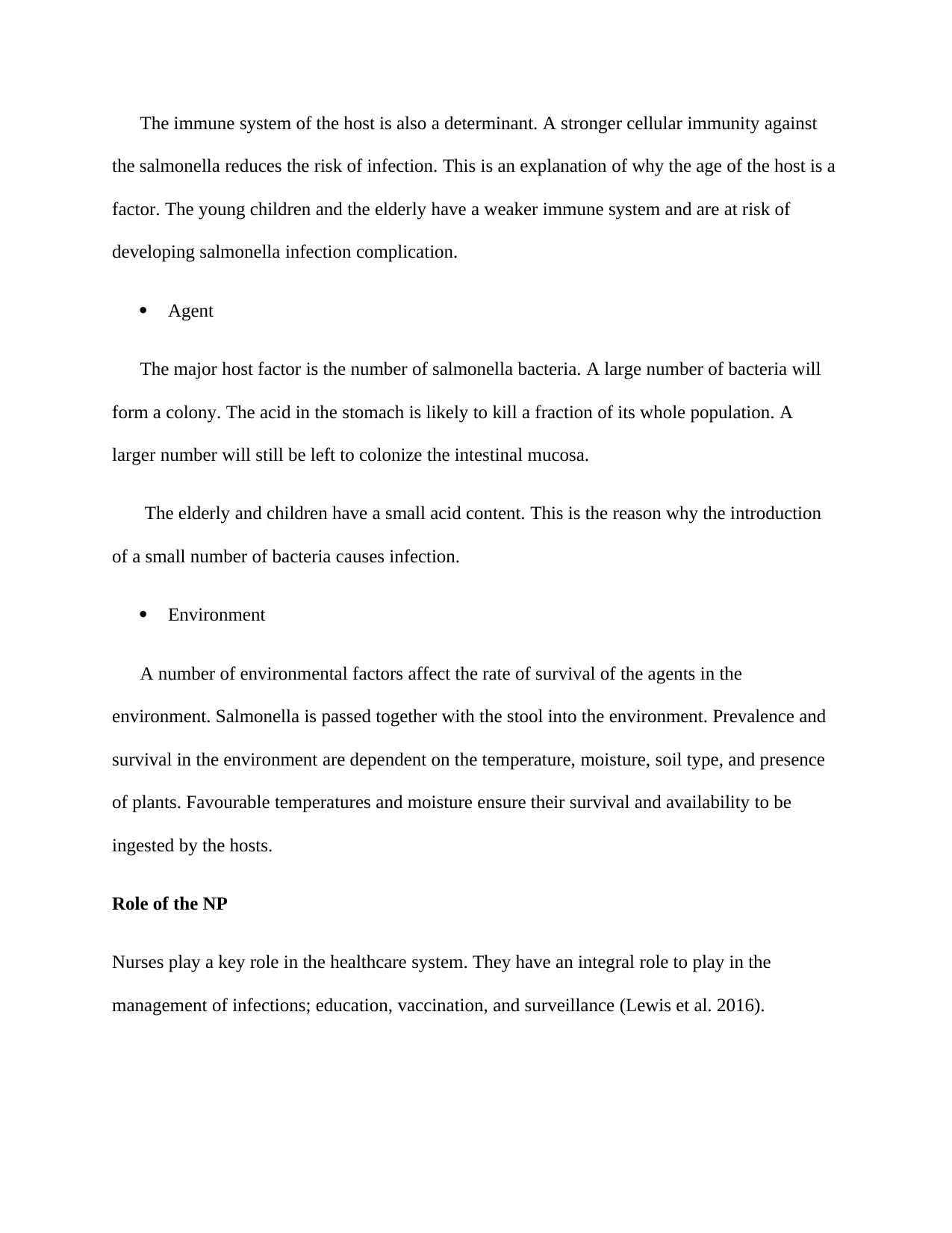
The immune system of the host is also a determinant. A stronger cellular immunity against
the salmonella reduces the risk of infection. This is an explanation of why the age of the host is a
factor. The young children and the elderly have a weaker immune system and are at risk of
developing salmonella infection complication.
Agent
The major host factor is the number of salmonella bacteria. A large number of bacteria will
form a colony. The acid in the stomach is likely to kill a fraction of its whole population. A
larger number will still be left to colonize the intestinal mucosa.
The elderly and children have a small acid content. This is the reason why the introduction
of a small number of bacteria causes infection.
Environment
A number of environmental factors affect the rate of survival of the agents in the
environment. Salmonella is passed together with the stool into the environment. Prevalence and
survival in the environment are dependent on the temperature, moisture, soil type, and presence
of plants. Favourable temperatures and moisture ensure their survival and availability to be
ingested by the hosts.
Role of the NP
Nurses play a key role in the healthcare system. They have an integral role to play in the
management of infections; education, vaccination, and surveillance (Lewis et al. 2016).
the salmonella reduces the risk of infection. This is an explanation of why the age of the host is a
factor. The young children and the elderly have a weaker immune system and are at risk of
developing salmonella infection complication.
Agent
The major host factor is the number of salmonella bacteria. A large number of bacteria will
form a colony. The acid in the stomach is likely to kill a fraction of its whole population. A
larger number will still be left to colonize the intestinal mucosa.
The elderly and children have a small acid content. This is the reason why the introduction
of a small number of bacteria causes infection.
Environment
A number of environmental factors affect the rate of survival of the agents in the
environment. Salmonella is passed together with the stool into the environment. Prevalence and
survival in the environment are dependent on the temperature, moisture, soil type, and presence
of plants. Favourable temperatures and moisture ensure their survival and availability to be
ingested by the hosts.
Role of the NP
Nurses play a key role in the healthcare system. They have an integral role to play in the
management of infections; education, vaccination, and surveillance (Lewis et al. 2016).
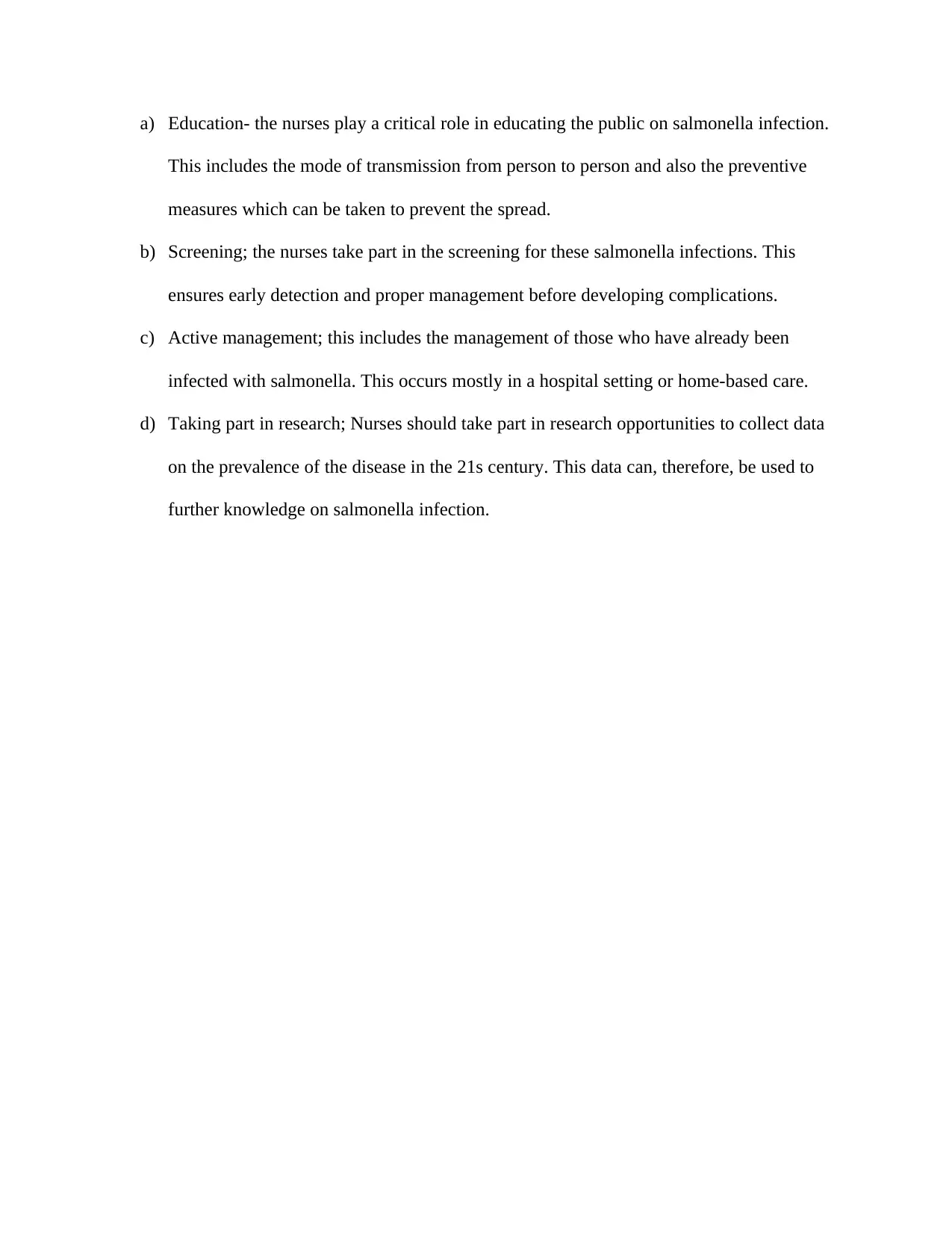
a) Education- the nurses play a critical role in educating the public on salmonella infection.
This includes the mode of transmission from person to person and also the preventive
measures which can be taken to prevent the spread.
b) Screening; the nurses take part in the screening for these salmonella infections. This
ensures early detection and proper management before developing complications.
c) Active management; this includes the management of those who have already been
infected with salmonella. This occurs mostly in a hospital setting or home-based care.
d) Taking part in research; Nurses should take part in research opportunities to collect data
on the prevalence of the disease in the 21s century. This data can, therefore, be used to
further knowledge on salmonella infection.
This includes the mode of transmission from person to person and also the preventive
measures which can be taken to prevent the spread.
b) Screening; the nurses take part in the screening for these salmonella infections. This
ensures early detection and proper management before developing complications.
c) Active management; this includes the management of those who have already been
infected with salmonella. This occurs mostly in a hospital setting or home-based care.
d) Taking part in research; Nurses should take part in research opportunities to collect data
on the prevalence of the disease in the 21s century. This data can, therefore, be used to
further knowledge on salmonella infection.
⊘ This is a preview!⊘
Do you want full access?
Subscribe today to unlock all pages.

Trusted by 1+ million students worldwide
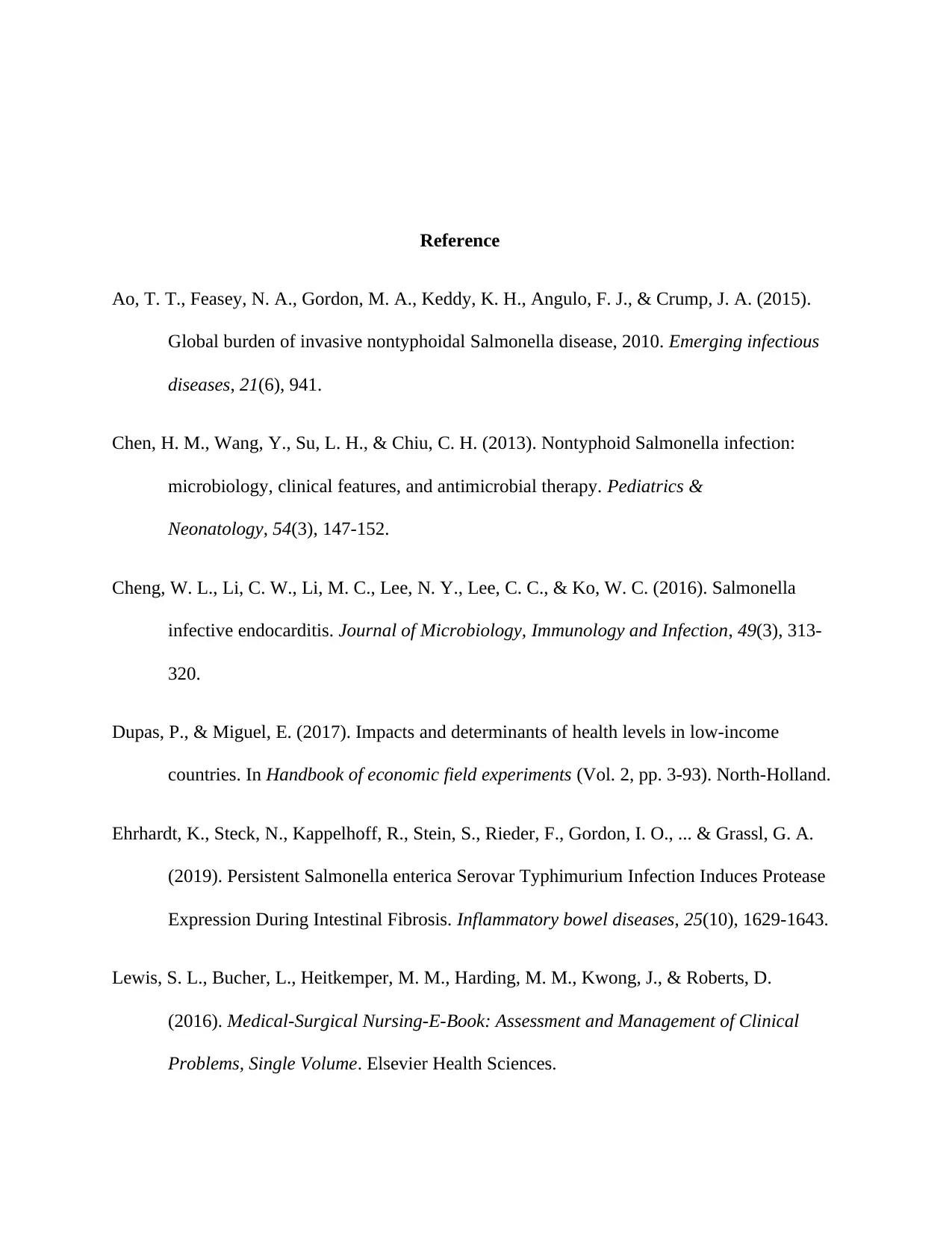
Reference
Ao, T. T., Feasey, N. A., Gordon, M. A., Keddy, K. H., Angulo, F. J., & Crump, J. A. (2015).
Global burden of invasive nontyphoidal Salmonella disease, 2010. Emerging infectious
diseases, 21(6), 941.
Chen, H. M., Wang, Y., Su, L. H., & Chiu, C. H. (2013). Nontyphoid Salmonella infection:
microbiology, clinical features, and antimicrobial therapy. Pediatrics &
Neonatology, 54(3), 147-152.
Cheng, W. L., Li, C. W., Li, M. C., Lee, N. Y., Lee, C. C., & Ko, W. C. (2016). Salmonella
infective endocarditis. Journal of Microbiology, Immunology and Infection, 49(3), 313-
320.
Dupas, P., & Miguel, E. (2017). Impacts and determinants of health levels in low-income
countries. In Handbook of economic field experiments (Vol. 2, pp. 3-93). North-Holland.
Ehrhardt, K., Steck, N., Kappelhoff, R., Stein, S., Rieder, F., Gordon, I. O., ... & Grassl, G. A.
(2019). Persistent Salmonella enterica Serovar Typhimurium Infection Induces Protease
Expression During Intestinal Fibrosis. Inflammatory bowel diseases, 25(10), 1629-1643.
Lewis, S. L., Bucher, L., Heitkemper, M. M., Harding, M. M., Kwong, J., & Roberts, D.
(2016). Medical-Surgical Nursing-E-Book: Assessment and Management of Clinical
Problems, Single Volume. Elsevier Health Sciences.
Ao, T. T., Feasey, N. A., Gordon, M. A., Keddy, K. H., Angulo, F. J., & Crump, J. A. (2015).
Global burden of invasive nontyphoidal Salmonella disease, 2010. Emerging infectious
diseases, 21(6), 941.
Chen, H. M., Wang, Y., Su, L. H., & Chiu, C. H. (2013). Nontyphoid Salmonella infection:
microbiology, clinical features, and antimicrobial therapy. Pediatrics &
Neonatology, 54(3), 147-152.
Cheng, W. L., Li, C. W., Li, M. C., Lee, N. Y., Lee, C. C., & Ko, W. C. (2016). Salmonella
infective endocarditis. Journal of Microbiology, Immunology and Infection, 49(3), 313-
320.
Dupas, P., & Miguel, E. (2017). Impacts and determinants of health levels in low-income
countries. In Handbook of economic field experiments (Vol. 2, pp. 3-93). North-Holland.
Ehrhardt, K., Steck, N., Kappelhoff, R., Stein, S., Rieder, F., Gordon, I. O., ... & Grassl, G. A.
(2019). Persistent Salmonella enterica Serovar Typhimurium Infection Induces Protease
Expression During Intestinal Fibrosis. Inflammatory bowel diseases, 25(10), 1629-1643.
Lewis, S. L., Bucher, L., Heitkemper, M. M., Harding, M. M., Kwong, J., & Roberts, D.
(2016). Medical-Surgical Nursing-E-Book: Assessment and Management of Clinical
Problems, Single Volume. Elsevier Health Sciences.
Paraphrase This Document
Need a fresh take? Get an instant paraphrase of this document with our AI Paraphraser
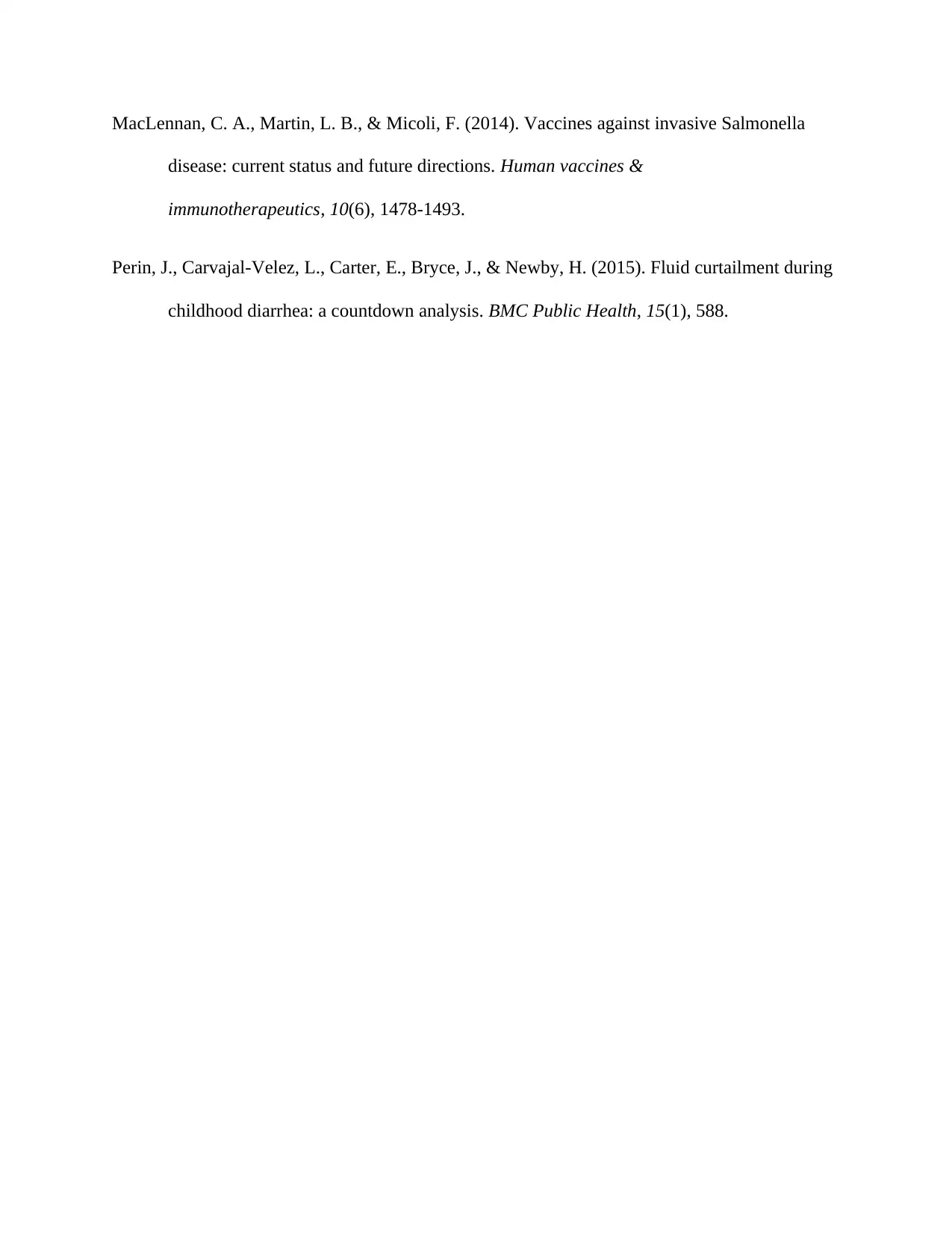
MacLennan, C. A., Martin, L. B., & Micoli, F. (2014). Vaccines against invasive Salmonella
disease: current status and future directions. Human vaccines &
immunotherapeutics, 10(6), 1478-1493.
Perin, J., Carvajal-Velez, L., Carter, E., Bryce, J., & Newby, H. (2015). Fluid curtailment during
childhood diarrhea: a countdown analysis. BMC Public Health, 15(1), 588.
disease: current status and future directions. Human vaccines &
immunotherapeutics, 10(6), 1478-1493.
Perin, J., Carvajal-Velez, L., Carter, E., Bryce, J., & Newby, H. (2015). Fluid curtailment during
childhood diarrhea: a countdown analysis. BMC Public Health, 15(1), 588.
1 out of 8
Related Documents
Your All-in-One AI-Powered Toolkit for Academic Success.
+13062052269
info@desklib.com
Available 24*7 on WhatsApp / Email
![[object Object]](/_next/static/media/star-bottom.7253800d.svg)
Unlock your academic potential
Copyright © 2020–2025 A2Z Services. All Rights Reserved. Developed and managed by ZUCOL.




